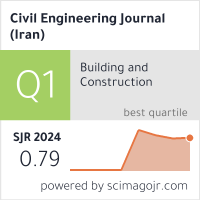Modelling of Crack Propagation in Layered Structures Using Extended Finite Element Method
Downloads
Crack propagation in structures is an important issue which is engineers and designers should consider. Modeling crack propagation in structures and study the behavior of this phenomenon can give a better insight to engineers and designers for selecting the construction's materials. Extended finite element method (XFEM) was used successfully in the past few years for simulating crack initiation and propagation in sophisticated and complex geometries in elastic fracture mechanics. In this paper, crack propagation in three-point bending beam including initial crack was modeled based on ABAQUS software. The following consequences were attained through the study of simulation data. First, the effects of young's modulus and fracture energy on force-displacement curve at three-point bending beam were investigated. It was observed that, by increasing the value of young's modulus and fracture energy, three-point bending beam was showed more load carrying against initiation. Second, in multi-layer beam, the effect of young's modulus on force-displacement curve was investigated. In case I (the thin upper layer is harder than the substrate) the value of young's modulus in substrate was kept constant and the amount of young's modulus in thin layer was risen in each step rather than the substrate, the peak in force-displacement curve was ascended and three-point bending beam resisted better against crack initiation. Next, similar conditions was considered in case II (the thin upper layer is softer than the substrate), by decreasing the value of young' modulus in top layer, peak in force-displacement curve was declined and crack initiation was happened in lower loading in each step. Finally, sensitivity analysis for thickness of top layer was conducted and the impact of this parameter was studied.
Downloads
[2] Moí«s, N., Dolbow, J., Belytschko, T. "A finite element method for crack growth without remeshing". International Journal for Numerical Methods in Engineering 46 (1999): 131–150.
[3] Sukumar, N., Moí«s, N., Moran, B., Belytschko, T. "Extended finite element method for three-dimensional crack modeling". International Journal for Numerical Methods in Engineering 48 (2000):1549–1570.
[4] Sukumar, N., Prévost, J. H. "Modeling quasi-static crack growth with the extended finite element method part I: computer implementation." International Journal of Solids and Structures 40 (2003): 7513–7537.
[5] Areias, P. M. A., Belytschko, T. "Analysis of three-dimensional crack initiation and propagation using the extended finite element method". International Journal for Numerical Methods in Engineering 63 (2005): 760–788.
[6] Dolbow, J., Moí«s, N., Belytschko, T. "An extended finite element method for modeling crack growth with frictional contact." Computer methods in applied Mechanics and engineering 190 (2001): 6825–6846.
[7] Belytschko, T., Chen, H., Xu, J., Zi, G. "Dynamic crack propagation based on loss of hyperbolicity and a new discontinuous enrichment." International journal for numerical methods in engineering, 58 (2003): 1873–18905.
[8] Belytschko, T., Hao, ch. "Singular enrichment finite element method for elastodynamic crack propagation."International journal of computional methods 1 (2004): 1–15.
[9] Grégoire, D., Maigre, H., Réthoré, J., Combescure, A. "Dynamic crack propagation under mixed-mode loading comparison between experiments and X-FEM simulations." International journal of solids and structures 44 (2008): 6517–6534.
[10] Prabel, B., Marie, S., Combescure, A. "Using the X-FEM method to model the dynamic propagation and arrest of cleavage cracks in ferritic steel. "Engineer fracture mechanics 75 (2008): 2984–3009.
[11] Cruse, T.A, Boundary Element Analysis in Computational Fracture Mechanics. Kluwer Academic Publisher, Dordrecht, 1988.
[12] Carter, B. J., Wawrzynek, P. A., Ingraffea, A. R. "Automated 3-D crack growth simulation." International journal for numerical methods in engineering 47 (2000): 229–253.
[13] Maligno, A. R., Rajaratnam, S., Leen, S. B., Williams, E. J. "A three-dimensional (3D) numerical study of fatigue crack growth using remeshing techniques." Engineer fracture mechanics 77 (2010): 94–111.
[14] Henshell, R. D., Shaw, K.G. "Crack tip finite elements are unnecessary." International journal for numerical methods in engineering 9 (1975): 495–507.
[15] Cao, P., Cao, Y., Li, J. "Using finite element software to simulation fracture behavior of three-point bending beam with Initial Crack." Journal of software 8 (2013): 1145-1150.
[16] Cervera, M., Pelí , L., Clemente, R., Roca, P. "A crack-tracking technique for localized damage in quasi-brittle materials." Engineering Fracture Mechanics, 77 (2010): 2431-2450.
[17] Rots, J. G. "Computational modelling of concrete fracture. Ph.D. Thesis." Delft University of Technology, 1988.
- Authors retain all copyrights. It is noticeable that authors will not be forced to sign any copyright transfer agreements.
- This work (including HTML and PDF Files) is licensed under a Creative Commons Attribution 4.0 International License.![]()















